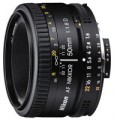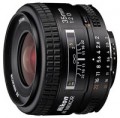Main function
The general purpose is rather conditional, and in fact the use of optics is not limited to the claimed direction — it all depends on the skills and imagination of the photographer. However, information about the specialization can greatly facilitate the choice. Considering such original options as a
cinema lens and
a multifunctional.
—
Architectural. Lenses designed primarily for shooting buildings. Most of these models are equipped with the Tilt-Shift system (see below). In this case, this function is intended to correct the perspective when shooting tall buildings. In a photograph taken with a normal lens, straight lines can turn out to be curved, which is unacceptable in cases where an accurate representation of the building in the picture is required. Using the Tilt-Shift system allows you to avoid this phenomenon and get a reliable image that does not require additional correction in a photo editor.
—
Landscape. In this case, landscape lenses include short-focus (wide-angle) lenses, which, according to test results, provide good image sharpness. In other words, not all “wide-angles” are classified as landscapes, but only those that are actually capable of providing a clear, sharp image.
—
Portrait. The hallmarks of a classic portrait lens are: first, the fixed focal le
...ngth, which is usually over 50mm (35mm equiv.); secondly, high aperture (most often not lower than f / 2.8, although occasionally there are exceptions). This combination of characteristics allows you to shoot portraits with beautiful background blur, placing the camera at a fairly significant distance; the latter can be useful in studios where additional lighting equipment is used — it is advisable to install the camera behind lighting fixtures so that it does not give a shadow. Speaking of a fixed focal length, it is worth recalling that "fixes" are simpler, lighter and cheaper than zoom lenses, and the ability to adjust the magnification when shooting portraits is rarely required — most often you can completely get by with "zoom with your feet".
— Multifunctional. This direction includes lenses of a universal type (see above), offering the buyer a good value for money; in other words — multi-purpose models with good performance and at the same time relatively inexpensive (namely, "comparatively", the actual price can be quite high). When choosing models in this category, the quality of filming was evaluated according to the results of real tests.
— Film lens. The main feature of cinema lenses is the ability to fine-tune the aperture. The aperture can be closed / opened by 0.1 or even 0.01 mm, while in photo lenses the aperture setting step cannot be less than 1 mm. Additionally, in cinema lenses, aperture is expressed by a T-number, and in photographic lenses, an F-number is used. The operator can shoot multiple cinema lenses with the same aperture, without the need to change the lighting. And when using photo lenses with the same aperture, you often have to adjust the lighting for each optic separately. Cinema lenses are meant to be shot from a tripod, which is reflected in their design features and design — such models are usually larger and heavier than their counterparts for photography.Aperture value
Lens aperture is a characteristic that determines how much the lens attenuates the light flux passing through it. It depends on two main characteristics — the diameter of the active aperture of the lens and the focal length — and in the classical form is written as the ratio of the first to the second, while the diameter of the active aperture is taken as a unit: for example,
1 / 2.8. Often, when recording the characteristics of a lens, the unit is generally omitted, such a record looks, for example, like this:
f / 1.8 or
f/2.0. At the same time, the larger the number in the denominator, the smaller the aperture value:
f / 4.0 lenses will produce a darker image than
models with f / 1.4 aperture.
Zoom lenses usually have different aperture values for different focal lengths. In this case, the characteristics indicate two aperture values, for the minimum and maximum focal lengths, respectively, for example: f / 4.5-5.6
The larger the aperture of the lens, the shorter shutter speeds it allows you to use when shooting. This is especially important when shooting fast-moving subjects, shooting in low light, etc. And if necessary, the light stream transmitted by the lens can be weakened using a diaphragm (see below).
Another point that directly depends on this indicator is the depth o
...f field (the depth of space that is in focus when shooting). The higher the aperture, the smaller the depth of field, and vice versa. Therefore, shooting with artistic background blur (bokeh) requires high-aperture optics, and for a large depth of field, you have to cover the aperture.Viewing angles
This parameter determines the size of the area of the scene being shot that falls into the frame. The wider the viewing angles, the larger the area the lens can capture in one shot. They are directly related to the focal length of the lens (see "Focal length"), and also depend on the size of the specific matrix with which the optics are used: for the same lens, the smaller the matrix, the smaller the viewing angles, and vice versa. On our website, in the characteristics of optics, viewing angles are usually indicated when used with the matrix for which the lens was originally designed (for more details, see "Matrix Size").
Minimum focus distance
Minimum focus distance (m) - the smallest distance from which you can focus on an object and take a photo. Usually it ranges from 20 cm for wide-angle lenses to several metres for telephoto. In the macro mode of the camera or with the help of macro lenses, this distance can be less than 1 centimeter.
Maximum zoom
The degree of magnification of the object being shot when using a
lens for macro shooting (that is, shooting small objects at the maximum possible approximation, when the distance to the subject is measured in millimetres). The degree of magnification in this case means the ratio of the size of the image of the object obtained on the matrix of the camera to the actual size of the object being shot. For example, with an object size of 15 mm and a magnification factor of 0.3, the image of this object on the matrix will have a size of 15x0.3=4.5 mm. With the same matrix size, the larger the magnification factor, the larger the image size of the object on the matrix, the more pixels fall on this object, respectively, the clearer the resulting image, the more details it can convey and the better the lens is suitable for macro photography. It is believed that in order to obtain macro shots of relatively acceptable quality, the magnification factor should be at least 0.25 – 0.3.

